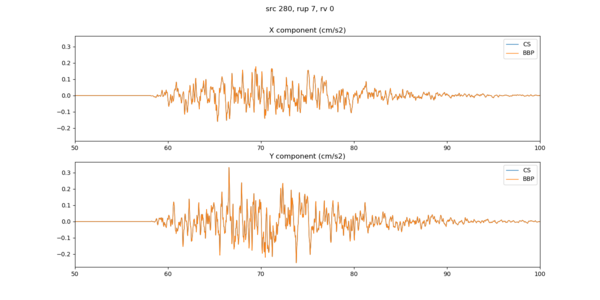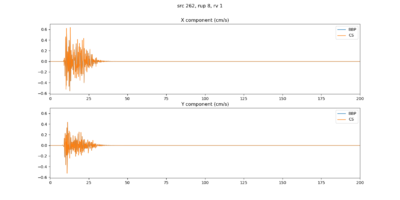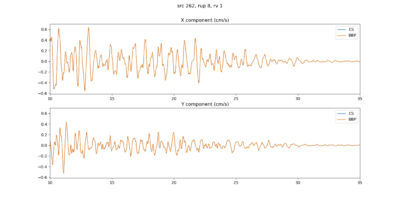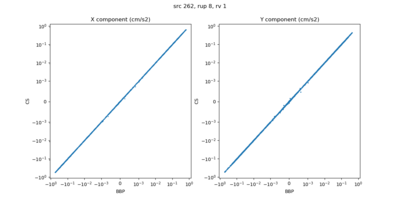CyberShake BBP Integration
This page details the process of integrating CyberShake with the Broadband Platform, so that we can produce stochastic high-frequency seismograms in CyberShake as a complement to deterministic low-frequency seismograms.
We performed a similar integration process for CyberShake 1.4 and CyberShake Study 15.12. This time, we would like to avoid maintaining a separate CyberShake version of the high-frequency stochastic codes. Instead, we would like to invoke the BBP codes from CyberShake, so that as new modifications are made to BBP, CyberShake can use these new codes without requiring the entire integration process again.
Contents
Approach
We have identified the following BBP executables, or elements, which are needed in CyberShake:
- srf2stoch (C)
- hb_high (Fortran)
- wcc_getpeak (C)
- wcc_siteamp14 (C)
- wcc_tfilter (C)
- wcc_resamp_arbdt (C)
- wcc_add (C)
- integ_diff (C)
As part of the BBP, each of these pieces of code contains a main() function, which typically works as follows:
main() {
// Parse command-line parameters
// Open and read input files into input data structure
// Execute science kernel, populating output data structure
// Open and write output files from output data structure
}
For CyberShake, we would like to be able to use the science kernels of the BBP elements, but provide CyberShake-specific parameters, pass data structures around in memory between multiple elements, and read from and write to different data formats. To accomplish this, we propose extracting the science kernels from the main() functions and creating subroutines with them, separating the I/O from the scientific calculations. Following this approach, a revised main method would contain:
main() {
// Open and read input files into input data structure
science_kernel_subroutine(command-line arguments, input_data_structure, output_data_structure)
// Open and write output files from output data structure
}
science_kernel_subroutine(command-line arguments, input_data_structure, output_data_structure) {
// Use input data structure for processing
// Place results in output data structure
}
Then, in the CyberShake codebase, we would use this function as follows:
// Open and read input files into input data structure // Allocate memory for output data structure // Create parameter string with CyberShake-specific parameters for getpar to parse science_kernel_subroutine(parameter_string, input_data_structure, output_data_structure) // Do additional processing with output data structure // Open and write output data structure to file
The intent is that these changes would be pushed out to the BBP codebase and also to Rob Graves, so that future revisions work from this refactored version and are straightforward to integrate with CyberShake.
Filename convention
Since for CyberShake we link the CyberShake code with the subroutine object files, the BBP main methods can't be in the subroutine object files (otherwise we would have multiple main()s), and must be contained in separate files. The convention we will follow is to have all subroutines in <module>_sub.c, and the main method with subroutine prototypes in <module>_main.c. The compiled executable used by BBP will have the name <module>_sub, to distinguish it from the non-refactored executables when testing.
Example
As an example, below we show the proposed modifications for wcc_getpeak. wcc_getpeak doesn't have an output data structure; in the BBP the result is printed, whereas in the subroutine it is returned.
| Change | Original code | Modified code |
|---|---|---|
| Subroutine prototype | N/A | float wcc_getpeak(int param_string_len, char** param_string, float* seis, struct statdata* head1); |
| Extract science kernel into subroutine |
int main(ac,av) { |
... |
| Relocate parsing of non-I/O parameters to subroutine | int main(ac,av) { |
float wcc_getpeak(int param_string_len, char** param_string, float* s1, struct statdata* head1) { |
| Retain I/O in main function |
int main(ac,av) |
int main(ac,av) |
Here is a way CyberShake code could use this modified code:
... float* seis = malloc(nt*sizeof(float)); fread(fp_in, sizeof(float), nt, seis); struct statdata head1; head1.nt = nt; char** param_string = NULL; float peak = wcc_getpeak(param_string, 0, seis, &head1); ...
Migration Status
| Element | Refactored | Passes BBP test | Called from CyberShake |
|---|---|---|---|
| wcc_getpeak | yes | yes | |
| wcc_add | yes | yes | |
| wcc_tfilter | yes | yes | |
| wcc_resamp_arbdt | yes | yes | |
| integ_diff | yes | yes | |
| wcc_siteamp14 | yes | yes | |
| hb_high | yes | yes | yes |
| srf2stoch | yes | yes | yes |
Verification
hb_high
hb_high is the most difficult code to verify, as it's the most complex.
To assist in verification, we constructed scatter plots comparing the value in CyberShake-calling-BBP to the value in BBP directly, for each point in the acceleration time series.
Our initial results are
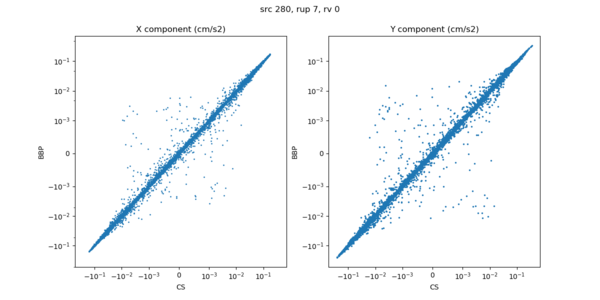
|
Upon further investigation, we uncovered a few issues.
- The default value in the BBP for kappa is 0.04, which is what we are using in CyberShake. However, when using the LA Basin velocity model, the default value is overwritten in the BBP and 0.045 is used instead. Once we updated to the right value of kappa, that improved the scatter a bit:
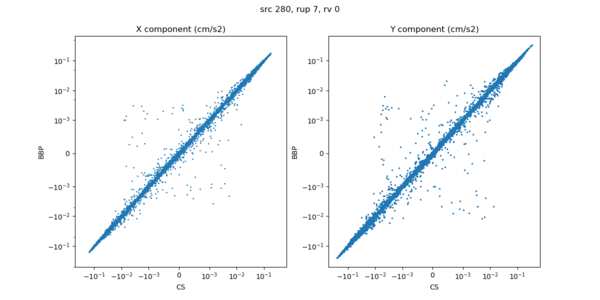
- In the CyberShake code, the geographic coordinates are rounded to 4 decimal places to agree with the output file that srf2stoch produces. However, this rounding is accomplished by multiplying, adding 0.5, casting to an int as a floor(), and then dividing. This is fine for positive numbers, but for negative numbers int and floor are not equivalent. Casting to an int will truncate towards 0, and floor() will truncate towards negative infinity. The rounding used when C writes files matches using floor().
Once this modification is also made, the seismograms very closely agree:
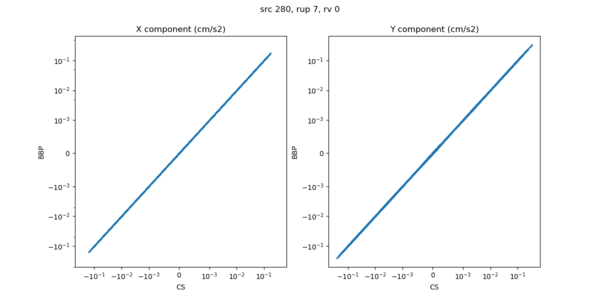
A visual comparison looks good:
A numerical comparison is also good:
Average absolute difference: 0.000000 Max absolute difference: 0.000005 Average absolute percent difference: 0.024559 Max absolute percent difference: 150.758352 Bins: 0.000000 <= reference amplitude < 0.010000: avg diff=0.000000, avg percent diff=0.028306% 0.010000 <= reference amplitude < 0.100000: avg diff=0.000000, avg percent diff=0.000988% 0.100000 <= reference amplitude < 1.000000: avg diff=0.000002, avg percent diff=0.001870% 1.000000 <= reference amplitude < 10.000000:
Site Response
Visual comparisons for source 280, rupture 7, rv 0:
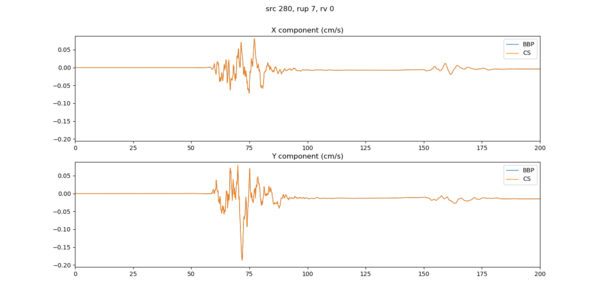
|
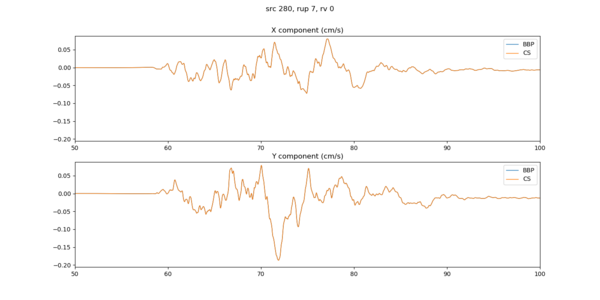
|
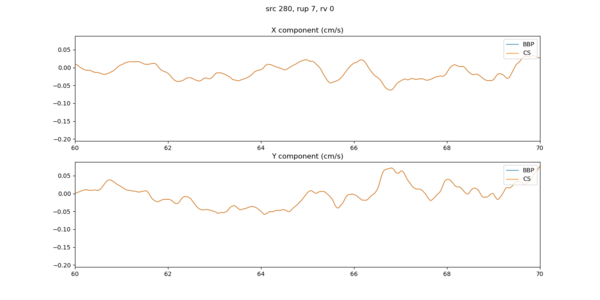
|
The scatterplot:
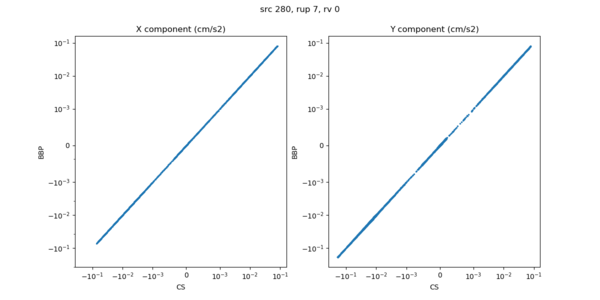
|
A numerical comparison looks good:
Average absolute difference: 0.000004 Max absolute difference: 0.000069 Average absolute percent difference: 0.265180 Max absolute percent difference: 265.281916 Bins: 0.000000 <= reference amplitude < 0.010000: avg diff=0.000001, avg percent diff=0.297034% 0.010000 <= reference amplitude < 0.100000: avg diff=0.000022, avg percent diff=0.076535% 0.100000 <= reference amplitude < 1.000000: 1.000000 <= reference amplitude < 10.000000: 10.000000 <= reference amplitude < 100.000000: 100.000000 <= reference amplitude < 1000.000000: 1000.000000 <= reference amplitude < 10000.000000:
Results for the other 9 ruptures:
